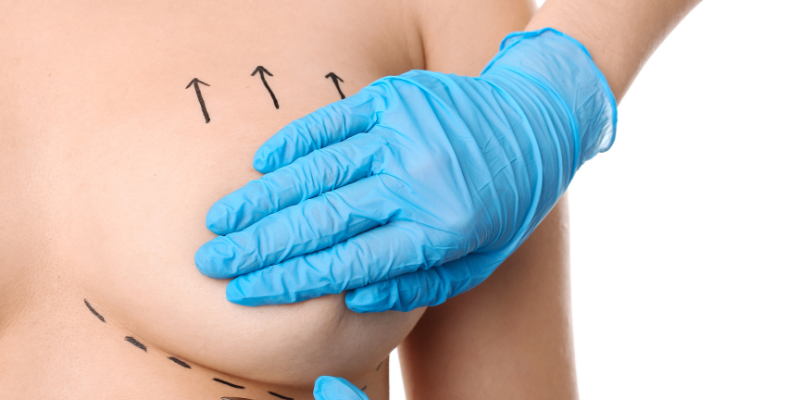What Is Areolar Herniation?
Areolar herniation refers to a condition in which the tissue under the nipple and areola (the darker skin surrounding the nipple) protrudes or bulges out abnormally after breast surgery. This bulging can cause the areola to become more prominent and can affect the aesthetic outcome of the surgery.
Understanding the Condition
In some cases, the areola becomes stretched or distorted, leading to an unnatural appearance. This can happen when there is increased pressure placed on the breast, especially after breast augmentation with implants, or as a result of trauma, post-operative swelling, or healing complications.
Breast surgery, whether for augmentation, reduction, or reconstruction, is a common procedure that can significantly enhance a woman's body image and self-confidence. However, like all surgical interventions, there can be potential complications that arise after the procedure. One such complication that women may encounter is areolar herniation.
This condition, though relatively rare, can be concerning for those who experience it. Understanding areolar herniation, its causes, and treatment options is important for anyone considering breast surgery.
Why Does Areolar Herniation Happen After Breast Surgery?
There are several factors that can contribute to areolar herniation following breast surgery, particularly when implants are involved. The protrusion occurs because the underlying tissue that supports the nipple and areola becomes weakened or disrupted. It can be particularly noticeable if the breast implant is positioned too high, or if the surgery has resulted in significant tissue displacement.
1. Implant Size and Placement: One of the most common reasons for areolar herniation is the use of larger breast implants that place significant pressure on the surrounding tissue. This pressure can stretch or damage the tissue around the nipple and areola, leading to a bulging effect. Additionally, if the implants are placed subglandular (over the muscle) rather than submuscular (under the muscle), there may be less tissue to provide support to the breast, increasing the likelihood of complications like herniation.
2. Implant Positioning: If the implants are positioned too high or not properly aligned during surgery, it can cause an imbalance in the breast tissue, leading to uneven pressure on the areola and potentially resulting in herniation.
3. Capsular Contracture: Capsular contracture occurs when the scar tissue that naturally forms around an implant tightens and hardens. This can lead to distortion of the breast tissue, causing the areola to stretch and possibly result in herniation.
4. Post-Surgical Swelling: Swelling after surgery is normal, but excessive swelling or complications during the healing process can exacerbate the chances of areolar herniation. If the tissue under the nipple and areola is already weak or stretched, post-operative inflammation can lead to further stretching.
5. Incorrect Healing: Healing is a delicate process, and if the tissue doesn't heal properly after breast surgery, it can result in complications. Poor healing may allow the implant or tissue to shift, contributing to areolar herniation.
6. Trauma or Pressure: External trauma to the breast, or even the pressure from a poorly fitted bra, can contribute to the development of areolar herniation. Women who return to heavy physical activity too soon or wear tight-fitting clothing after surgery may be more prone to this issue.
Understanding the causes, risks, and treatment options for this condition can help women feel more confident in their surgical decisions and work with a skilled surgeon to achieve the best results.
Fixing Areolar Problems: Treatment Options for Areolar Herniation
If you are experiencing areolar herniation in Mumbai or any related breast implant complications, it's important to consult with a qualified surgeon who specializes in breast surgery. Fortunately, there are several ways to address this issue, depending on the severity of the herniation.
Revision Surgery
In cases of significant areolar herniation, revision surgery may be required to correct the position of the implant or adjust the tissue. The surgeon can reposition implants, reduce their size, or shift them to a submuscular position for better support.
Correcting Capsular Contracture
If capsular contracture is contributing to areolar herniation, your surgeon may need to remove or adjust the scar tissue surrounding the implant to reduce tightness and restore normal tissue function.
Non-Surgical Options
In some instances, areolar herniation can be addressed with less invasive treatments, such as massage therapy or special compression garments to help realign breast tissue and relieve pressure on the areola.
Proper Post-Operative Care
Taking the right steps during recovery can help prevent or reduce the risk of areolar herniation, including following aftercare instructions, wearing supportive bras, and limiting physical activity until fully healed.
What Causes Areolar Herniation After Breast Surgery?
Areolar herniation occurs when the tissue supporting the nipple and areola is stretched or weakened after surgery. This is typically due to factors like the size of the implant, improper implant placement, capsular contracture, or excessive swelling during recovery.
How Can Areolar Herniation Be Treated?
Treatment for areolar herniation usually involves revision surgery to reposition the implants or correct any underlying issues, such as capsular contracture. In some cases, less invasive treatments like massage or compression garments can help alleviate minor cases. However, more severe cases typically require surgical intervention to restore a natural breast shape.
In some cases, the surgeon may also need to perform a mastopexy (breast lift) to tighten the surrounding skin and improve the overall appearance of the breast. This can help to reduce the protrusion of the areola and restore a more natural look.
While areolar herniation is not a common complication following breast surgery, it can still happen in some cases. Whether you're dealing with implant complications or simply want to learn more about potential nipple and areola issues, it's important to work with a skilled surgeon to achieve the best results. If you're experiencing any concerns about areolar herniation in Mumbai, it's crucial to consult with a trusted professional who can assess your individual situation and recommend the most appropriate treatment plan.

